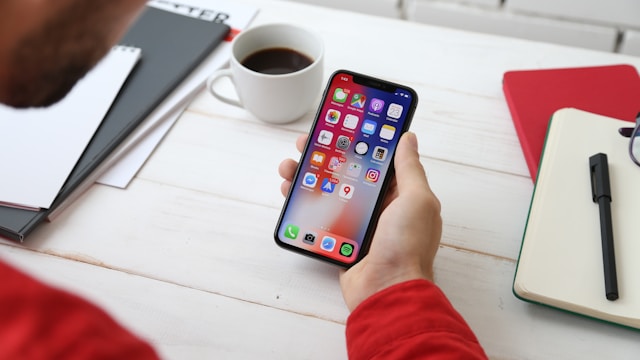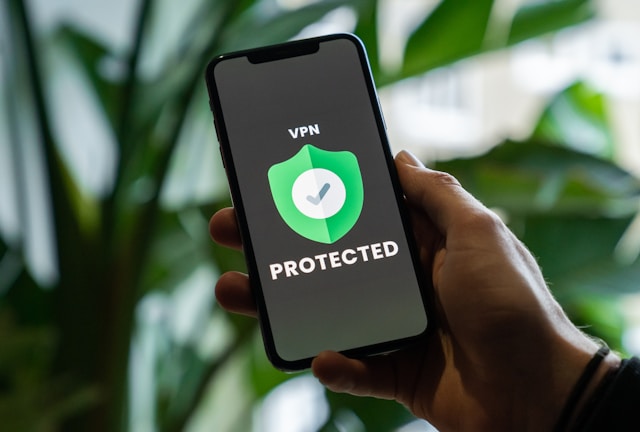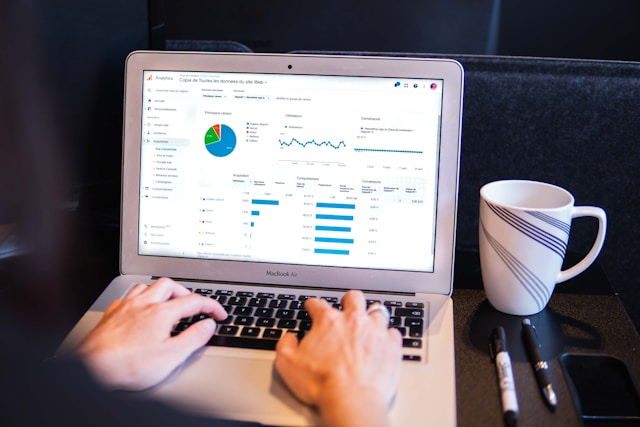Are you interested to learn more about geolocation applications? Then, you’ll find this article useful to learn more about the basics. You’ll discover the basics of building an app and how to choose one yourself.
Keep reading to learn more about location-based apps and their uses!

Table of Contents
What Is Geolocation?
Geolocation refers to the process of determining the physical location of a device, such as a smartphone, computer, or global positioning satellite (GPS) unit. It combines information from GPS satellites, Wi-Fi networks, cell towers, IP addresses, and Bluetooth beacons. These technologies can pinpoint the device’s location on the Earth’s surface.
Here’s a summary of the different technologies that you can use to determine geolocation data:
- GPS: This technology makes use of satellite data, which is effective in open areas with a clear view of the sky.
- Wi-Fi positioning: This makes use of Wi-Fi networks, which is handy when targeting users indoors or in urban environments.
- Cell tower triangulation: This estimates the location by measuring signal strength from multiple cell towers. Also, geolocation accuracy is less precise than that of GPS.
- IP addresses: You can use IP addresses to determine the geolocation of users that connect to the internet.
- Bluetooth beacons: These use low-energy Bluetooth signals from beacons placed in specific locations. This is beneficial because it enhances indoor positioning accuracy and is useful in places like malls or airports.

Geolocation Applications: Top 5 Uses of Geotargeting
Now, let’s turn our attention to the top five uses of geotargeting when using geolocation apps. Therefore, you can determine if you are using these apps for your business or processes.
However, this list is just a small example, and there are many other uses of geolocation data.
1. Location-Based Advertising
Location-based advertising leverages geolocation data to deliver targeted advertisements to users based on their current or recent locations. Therefore, by understanding where a user is or has been, businesses can tailor their marketing efforts to be more relevant and timely.
For example, a coffee shop can send promotional offers to potential customers who are nearby. This increases the likelihood of attracting foot traffic.
Furthermore, retailers can use geotargeting to advertise special deals when users are near their stores. This method increases the effectiveness of advertising campaigns, improves customer engagement, and enhances the return on investment (ROI) for marketers.
Finally, businesses can create a more personalized shopping experience by reaching users with contextually relevant ads.
2. Local Search Optimization
Geotargeting plays a crucial role in local search optimization by helping businesses appear in search results when users look for services or products nearby.
For example, a user might search for “restaurants near me” or “car repair in [city].” Search engines will use geolocation data to provide relevant local results.
This is particularly beneficial for small and medium-sized businesses that rely on local customers. Businesses can improve their visibility in local searches by optimizing their online presence with local SEO techniques.
Hence, you’ll attract more customers and drive traffic with real-time updates. Geotargeting ensures that users find the most relevant local options quickly and easily. Therefore, you’ll improve their overall experience when using location-based applications.

3. Emergency Services and Safety
Geolocation is vital for emergency services and safety applications since they need to visit physical locations quickly.
Therefore, when individuals call emergency services, the geolocation data helps dispatchers accurately identify their location. This is even possible if the caller cannot provide it in a timely manner.
The technology can be crucial in situations where time is of the essence, such as medical emergencies, fires, or natural disasters.
Additionally, public safety geolocation mobile apps can also use geotargeting to send alerts about nearby hazards. This includes severe weather conditions or accidents. It helps ensure that people in the affected area receive timely warnings.
Additionally, family locator apps use geolocation to help parents keep track of their children’s whereabouts to enhance safety. The geolocation tracking apps can notify parents when their kids leave a specific area. Also, parents can make use of geofencing to establish the area where their kids can play.
4. Fleet Management and Logistics
Geolocation is a key component in fleet management and logistics since it allows companies to monitor and optimize the movement of their vehicles and assets. They can track the real-time location of delivery trucks, service vehicles, and other assets. The advantage is being able to improve route planning, reduce fuel consumption, and enhance overall efficiency.
Furthermore, geotargeting enables dynamic routing, helping drivers avoid traffic congestion and reach their destinations faster. This means logistics companies can provide customers with accurate delivery times and updates. Customers will love this as it improves transparency and customer satisfaction.
Logistics companies can also use geolocation data to aid in asset recovery and theft prevention. This ensures you can monitor and protect valuables at all times.
5. Tourism and Travel Assistance
Geotargeting benefits the tourism and travel industry by offering personalized and contextually relevant information. Travel geolocation apps can provide real-time information about nearby attractions, historical sites, restaurants, and events.
Additionally, geotargeting can offer navigation assistance to guide tourists through unfamiliar cities and suggest points of interest along their route. For museums and cultural sites, geotargeting can enhance visitor experiences by providing location-based audio guides and information.
This tailored approach helps travelers maximize their experience by discovering hidden gems and avoiding common tourist pitfalls. It ensures tourists can do more within the time limits of their vacation. Also, apps that provide several languages can help tourism overcome the local language barrier.

How To Create a Location Based Mobile Application
Do you want to learn key steps that involve the creation of a location-based mobile application? This section provides a basic overview of what to expect when making preparations to build these apps. There’s a lot of help out there for location-based app creation for a wide range of geolocation services. Here are the top steps to consider:
- Define the app’s purpose and features: You’ll need to identify the target audience by understanding who will use your app and what problems it will solve for them. Hence, decide on the essential features like real-time location tracking, geofencing, location-based notifications, and map integration. Also, it’s a good idea to outline the app’s goals. This includes user engagement, data collection, or providing location-specific services.
- Research and choose the technology stack: Start by deciding on the platforms on which you want to develop the app, which can be iOS, Android, or both. Also, you’ll need to choose a service that provides a geolocation API. Next, you’ll need to select development frameworks and tools. This will be instrumental in building the type of app that meets your objectives.
- Design the user interface and experience: You must create wireframes to outline the app’s structure and navigation flow. Also, it’s a good idea to develop interactive prototypes to visualize the app’s functionality. Finally, focus on a user-friendly interface with intuitive navigation. Make sure that the map views and location-based features are easily accessible.
- Ensure data privacy and security: You’ll need to develop the app by taking data privacy and security into account. Hence, request location permissions from users in a clear and transparent manner. Then, don’t forget to encrypt sensitive data both in transit and storage. Finally, create and display privacy policies that explain how you collect, use, and store the data.

How To Choose Location Based Services Apps
Learning how to choose a location-based services app by paying attention to the points that matter is a good idea.
In this section, we’ll present three factors to consider when identifying a noteworthy app for mobile devices.
1. Evaluate Key Features
Identifying the app’s key features to gauge its effectiveness is a good idea. Start by examining the accuracy to ensure that it matches your margin for error. You’ll also want to examine how the app performs in different environments, which include urban and rural.
You’ll also want to examine the user interface to determine if it’s easy to use. You may need to download the app and use it for yourself to make an accurate judgment. This is arguably the most time-consuming aspect of choosing the right app.
Furthermore, it helps if there are real-time updates for tracking and notifications. This feature makes geoloc applications more user-friendly.
2. Research the Marketplace
It’s handy to browse the Google Play Store and Apple App Store for popular apps. In a number of categories, there are a large number of apps that you can download. Some of these offer a free trial, which allows you to test the offerings without getting out your credit card.
Take the time to read the reviews and ratings to focus on the apps with the best feedback. This ensures that you only consider the top-performing apps for your use case. The popular pass may have hundreds or thousands of reviews, which will help you set the right expectations.
3. Assess Privacy and Security
Review the app’s privacy policy to understand how your location data is collected, used, and stored. Look for apps prioritizing user privacy to ensure your data doesn’t fall into the wrong hands.
Furthermore, ensure the app requests appropriate permissions and does not overreach its access to your device’s data. Don’t share any data that you’re uncomfortable giving to strangers. After all, it’s common practice for rogue apps to harvest data and sell the information to brokers.
Finally, check if the app uses encryption and other security measures to protect your data. You may need to contact customer support to get more information. This also gives you an opportunity to test the quality of the customer support.

FAQ: Frequently Asked Questions
How do apps ensure user privacy with geolocation data?
Apps ensure user privacy by requiring explicit permission to access location data. Therefore, users can control location-sharing settings, and apps often encrypt location data to protect privacy.
Furthermore, regulatory frameworks like the General Data Protection Regulation (GDPR) and the California Consumer Privacy Act (CCPA) also impose strict guidelines. This sets the rules for how apps must share, collect, and store data.
Can geolocation be used indoors?
Yes, you can use geolocation indoors, but it is typically less accurate than outdoors. It’s possible through technologies like Wi-Fi and Bluetooth beacons.
These methods are particularly useful in large indoor spaces like shopping malls and airports.

How does geofencing work in apps?
Geofencing creates a virtual boundary around a specific geographic area. The app triggers a predefined action when a device enters or exits this area.
This might be to send notifications, alert the user, or start a process. You can widely use notifications in marketing, security, and location-based reminders.
What are the battery consumption implications of using geolocation in apps?
Geolocation services like GPs can consume significant battery power. To mitigate this, apps can use less power-intensive methods like Wi-Fi or cell tower positioning. This is especially a good idea when high accuracy is not necessary.
Furthermore, implement smart usage patterns like updating location data at longer intervals or based on significant movement changes.
How do location-based services benefit businesses?
Location-based services enable businesses to offer personalized experiences. This includes targeted advertising, localized promotions, and enhanced customer support. They can also gather valuable data on customer behavior and preferences.
Therefore, you can optimize delivery and logistics operations and improve the efficiency of field services and asset tracking.
Can users fake their geolocation data?
Yes, users can spoof or fake their geolocation data using various methods, such as VPNs, GPS spoofing apps, or modifying device settings. You can use this for privacy protection, bypassing geographic restrictions, or cheating in location-based games.
However, such actions may violate the app’s terms of service and lead to penalties.
What challenges do developers face when integrating geolocation into apps?
Developers face challenges such as ensuring accuracy, managing battery consumption, and maintaining user privacy. Therefore, handling different location technologies and data sources helps provide a seamless user experience.
Additionally, they must comply with legal regulations on data collection and use. This ensures their apps function across various devices and environments.
How do weather conditions affect geolocation accuracy?
Weather conditions can impact GPS signals by reducing their accuracy. Heavy rain, snow, or cloud cover can also weaken satellite signals, which leads to less precise positioning.
However, alternative methods like Wi-Fi and cell tower triangulation are less affected by weather. These technologies can provide more consistent accuracy under adverse conditions.

Geolocation Apps Are Highly Effective
The technologies at play with geolocation apps are impressive and play a massive role in many services. This includes anything from Google Maps to other location-based technology companies.
Also, the accuracy and speed of these services constantly improve, which expands the number of use cases.
Remember to use the points in this article to choose the right geolocation applications. Also, you can create an application of your own with the vast array of helpful tools out there. Hence, you can use the geolocation data to improve your services as a business or organization.
Do you want access to geolocation data to create your app? Then, take advantage of the services here at geoPlugin. We can provide location-based data from IP addresses, which you can use to target users. So what are you waiting for?
Start your journey with geoPlugin to skyrocket your geolocation app’s success!











